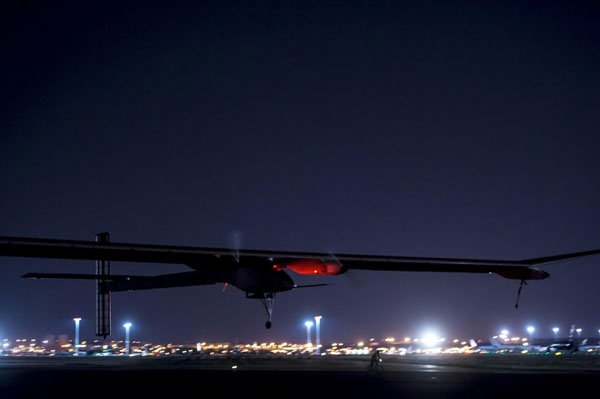Solar plane completes maiden intercontinental trip
Updated: 2012-06-06 10:06
(Agencies)
|
||||||||
SALE, Morocco - A solar energy plane landed in Morocco on Tuesday, completing the world's first intercontinental flight powered by the sun to show the potential for pollution-free air travel.
The Solar Impulse took off from Madrid at 0322 GMT on Tuesday and landed at Rabat's International airport after a 19-hour flight.
Shortly before Swiss pilot Bertrand Piccard landed in Rabat's airport, the project co-founder and pilot Andre Borschberg said the aircraft has proved its sustainability.
"The aircraft can now fly day and night. It's quite a show ... It's a technology we can trust," he told reporters.
Pilot Piccard descended from the plane, smiling as he was greeted by Borshberg and Mustafa Bakkoury, the head of Morocco's solar energy agency.
The Solar Impulse project began in 2003 with a 10-year budget of 90 million euros ($112.18 million) and has involved engineers from Swiss lift maker Schindler and research aid from Belgian chemicals group Solvay.
On Tuesday, the aircraft crossed the Gibraltar Strait separating Africa and Europe at one of its narrowest points. The flight is crucial for the project's developers because it would help improve the organization of a world tour planned in 2013.
The plane, which requires 12,000 solar cells, embarked on its first flight in April 2010 and completed a 26-hour flight, a record flying time for a solar powered aircraft, three months later.
It made its first international flight last month when it completed a 13-hour flight from the western Swiss town of Payern to Brussels.
With an average flying speed of 70 km/h (44 mph), Solar Impulse is not an immediate threat to commercial jets, which can easily cruise at more than 10 times the speed. A flight from Madrid to Rabat can take a little more than an hour.
Project leaders acknowledged it had been a major challenge to fit a slow-flying plane into the commercial air traffic system.

 Relief reaches isolated village
Relief reaches isolated village
 Rainfall poses new threats to quake-hit region
Rainfall poses new threats to quake-hit region
 Funerals begin for Boston bombing victims
Funerals begin for Boston bombing victims
 Quake takeaway from China's Air Force
Quake takeaway from China's Air Force
 Obama celebrates young inventors at science fair
Obama celebrates young inventors at science fair
 Earth Day marked around the world
Earth Day marked around the world
 Volunteer team helping students find sense of normalcy
Volunteer team helping students find sense of normalcy
 Ethnic groups quick to join rescue efforts
Ethnic groups quick to join rescue efforts
Most Viewed
Editor's Picks

|

|

|

|

|

|
Today's Top News
Health new priority for quake zone
Xi meets US top military officer
Japan's boats driven out of Diaoyu
China mulls online shopping legislation
Bird flu death toll rises to 22
Putin appoints new ambassador to China
Japanese ships blocked from Diaoyu Islands
Inspired by Guan, more Chinese pick up golf
US Weekly

|

|







